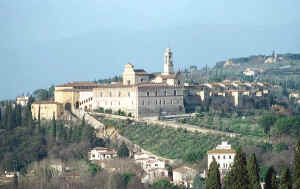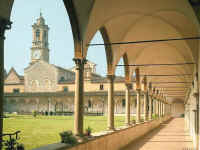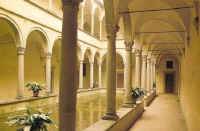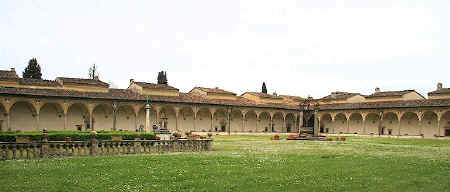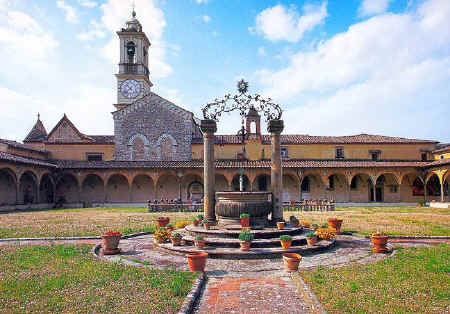|
The Certosa del Galluzzo is prominently situated on a hillside just south of Florence and is clearly visible as a huge walled structure to travellers on the motorway from Florence to Sienna and on the SR1 road from Florence to San Casciano. Niccolò Acciaiuoli, one of the most powerful citizens of 14 C Florence, had the Certosa of Galluzzo built in 1341 not only as a religious centre but also for the education of the young. The Acciaiuoli (Acciaioli) Palace where the youth of Florence were taught towers upwards alongside the religious buildings of the monastery. Galluzzo was one of the most influential monasteries in Europe and was immensely wealthy, with a population of hundreds of monks and, until the Napoleonic depredations, large numbers of works of art. Its huge library is now dispersed. Certosa of Galluzzo panorama The Church of Saint Lawrence is Mannerist in architectural style and filled with frescoes and pictures, a sumptuous marble altar of the 16 C and a crypt containing many tombs, mainly of the Acciaioli family. The church gives access to the beautiful Renaissance cloister with its large terracotta well by Andrea and Giovanni della Robbia. The monks' cells open onto this cloister, and those which are open to the public give an idea of Carthusian monastic life. Each consists of a room for sleeping and a room for praying. Their furnishings are severe but, as in all Carthusian monasteries, each has a tiny enclosed garden which was cultivated individually by the inhabitant. In addition to the large cloister, the small Chiostro dei Conversi is open to the public. This consists of two superimposed loggias, and gives access to the refectory which is decorated with a large wash basin in pietra serena and a pulpit from which lessons were read during meals. Five fresco lunettes by Pontormo showing scenes from Christ's Passion were originally in the large cloister, but are now found in the monastery's gallery with other works of art of the 14 C to 18 C.
In 1957, a small group of Cistercian friars replaced the Carthusian monks as the inhabitants of the Certosa. They are largely self-supporting and maintain their old traditions such as the distillation of herb liqueurs and the manufacture of small handmade religious articles. Visits are possible under the guidance of a monk from Tuesday to Sunday from 9am-12pm and from 3-6pm. A tour of the Certosa of Galluzzo The monastery can be reached by car from Florence by taking Via Senese from Piazzale di Porta Romana as far as
Galluzzo, passing through about three
km of hills covered in olive groves and dotted with Tuscan villas, and then
along a short avenue climbing up to the Certosa. It can also be be reached by bus 37 that leaves from
outside the main (Santa Maria Novella) railway station. From Greve in
Chianti, take the road to Florence that passes through Ferrone (i.e. not SS 222
through Strada and Grassina) Certosa of Galluzzo chiostro grande The Church of San Lorenzo is divided into two longitudinally placed and separate areas: the first was for the "lay brothers", who carried out various practical duties for the monks, while the second, nearest the altar, was reserved for the cloistered monks. The first part of the church and the facade were built at the same time as the courtyard, while the "church of the monks" still maintains its ancient Gothic structure, a single room, roofed over with cross
vaults. The interior was however completely remodelled in the 16 C, enriched with the marble altar, the new chancel,
and decorated with wooden inlays and the frescoes by Bernardino Poccetti. This co-existence of mediaeval structures with later
additions characterises the whole of the monastery, starting with the corridor on the left of the church where, once a week, the monks were allowed to gather together and interrupt their vows of silence. At the end of the
corridor there is a fine Christ carrying the Cross by Andrea della Robbia and the elegant little cloister that acts as a fulcrum for the entire
complex. From here a door, decorated with a St. Laurence between two angels in terracotta by Benedetto da Maiano,
leads through to the refectory, the main cloister and the Chapter House, where the monks used to meet to discuss any problems that touched
upon their community. |
